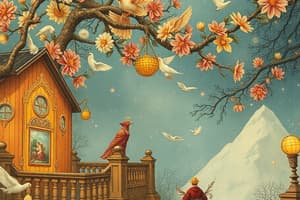Podcast
Questions and Answers
What literary device involves the repetition of initial consonant sounds in closely placed words?
What literary device involves the repetition of initial consonant sounds in closely placed words?
- Metaphor
- Imagery
- Symbolism
- Alliteration (correct)
Which literary device is a direct comparison between two unlike things without using 'like' or 'as'?
Which literary device is a direct comparison between two unlike things without using 'like' or 'as'?
- Simile
- Metaphor (correct)
- Hyperbole
- Personification
What does the literary device of personification involve?
What does the literary device of personification involve?
- Exaggeration for emphasis
- Hints about future events in a narrative
- Assigning human traits to non-human objects (correct)
- Contradictory terms combined
Which of the following is an example of symbolism?
Which of the following is an example of symbolism?
What type of literary device uses exaggerated statements not meant to be taken literally?
What type of literary device uses exaggerated statements not meant to be taken literally?
Which literary device is characterized by a contrast between expectation and reality?
Which literary device is characterized by a contrast between expectation and reality?
Which device is used when an author hints at events that will occur later in the story?
Which device is used when an author hints at events that will occur later in the story?
What literary device involves the repetition of a word or phrase at the beginning of successive clauses?
What literary device involves the repetition of a word or phrase at the beginning of successive clauses?
Flashcards are hidden until you start studying
Study Notes
Literary Devices
-
Definition: Techniques that writers use to convey their message, enhance their writing, and develop their themes.
-
Types of Literary Devices:
-
Alliteration: Repetition of initial consonant sounds in closely placed words.
- Example: "She sells seashells by the seashore."
-
Metaphor: A direct comparison between two unlike things without using "like" or "as".
- Example: "Time is a thief."
-
Simile: A comparison between two unlike things using "like" or "as".
- Example: "Her smile was as bright as the sun."
-
Personification: Assigning human characteristics to non-human entities.
- Example: "The wind whispered through the trees."
-
Symbolism: The use of symbols to represent bigger ideas or concepts.
- Example: A dove symbolizes peace.
-
Imagery: Descriptive language that appeals to the senses, creating vivid pictures in the reader's mind.
- Example: "The golden sun set behind the purple mountains."
-
Irony: A contrast between expectation and reality; includes verbal, situational, and dramatic irony.
- Example: Saying "What a pleasant day!" during a storm.
-
Foreshadowing: Hints or clues about what will happen later in a story.
- Example: Dark clouds may foreshadow a storm.
-
Hyperbole: Exaggerated statements not meant to be taken literally.
- Example: "I’m so hungry I could eat a horse."
-
Oxymoron: A figure of speech that combines contradictory terms.
- Example: "Bittersweet."
-
Chiasmus: A rhetorical device where two or more clauses are balanced against each other by the reversal of their structures.
- Example: "Ask not what your country can do for you, ask what you can do for your country."
-
Anaphora: The repetition of a word or phrase at the beginning of successive clauses.
- Example: "I have a dream..."
-
-
Purpose of Literary Devices:
- Enhance storytelling.
- Engage the reader’s imagination.
- Convey complex ideas and emotions.
- Create rhythm and musicality in writing.
Studying That Suits You
Use AI to generate personalized quizzes and flashcards to suit your learning preferences.




